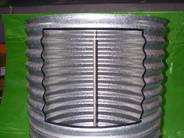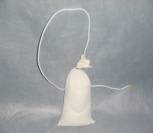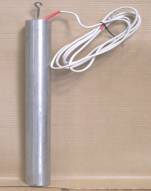AnoGuard produce a range of anode kits to suit wall hugging "Modular" domestic
style rainwater tanks ranging from 400 litres to 2200 litres capacity
through to 450 litres to 22000 litres "Round Corrugated" domestic
raintanks and finally both "bolt-on" and suspended style anodes
for large sized rural tanks containing either rain or ground water (water
type must be nominated when ordering as different anodes are required).
Kit Selection
Guide
MODULAR
TANKS [Rectangular look]
|
Tank
height
|
Length |
Capacity |
Kit
Part No.
|
840mm
(2'9")
|
600-1740mm
(2'0"-5'9")
|
400-1650L
(90-360gal)
|
ANK690/21S
|
1140mm
(3'9")
|
1140-2340mm
(3'9"-7'8")
|
750-2200L
(165-500gal)
|
ANK970/21S |
1120-1140mm
(3'8" - 3'9)
|
2340-2470mm
(7'8" - 8'.0")
|
1500-2200L
(340-500gal)
|
ANK970/21S2
(Double anode kit)
|
2480mm
(8'0")
|
1400-2530mm
(4'7"-8'4")
|
1300-12500L
(300-2800gal)
|
ANK2330/27R
|
1870mm
(6'0")
|
2800-3500mm
(9'4"-11'6")
|
11700-18000L
(2500-4000gal)
|
ANK1720/21R2
(Dual Anodes) |
2480mm
(8'0") |
3000-3400mm
(10'0"-11'2")
|
17500-22500L
(4000-5000gal)
|
ANK2330/21R2
(Dual Anodes)
|
3100mm
(10'0") |
3000mm
(10'0")
|
22000L
(5000gal)
|
ANK2890/21R2
(Dual Anodes)
|
| ROUND
CORRUGATED TANKS |
650mm
(2'0") |
950mm
(3'2") |
450L
(100gal) |
ANK500/27R |
1250mm
(4'0") |
950-2150mm
(3'2"-7'1") |
900-4450L
(200-1000gal) |
ANK1100/27R |
1870mm
(2'0") |
950-2530mm
(3'2"-8'4") |
1300-9400L
(300-2000gal) |
ANK1720/27R |
|

|
Tank with cutaway section showing
“
domestic” suspended anode |

|
| “Bagged Anode” used to protect external surfaces
on ground mounted rural tanks. |
 |
"Suspended Anode” for
large rural water tanks
|
|
Each kit comprises either a 21mm or 27mm diameter
Magnesium sacrificial anode, suspending copper cable,
tank roof fastener, tek screws, nut setter and installation and
operating instructions.
PLEASE NOTE: Some kits contain
dual anodes. A single anode kit may be substituted but will require
more frequent replacement.
DETAIL
SPECIFICATION |
Anode Material: Designated M1 high potential
extruded magnesium rod to AS2239-2003.
Cable: P.V.C. coated 7/1.04 copper cable of appropriate length
with attaching eye.
Roof Fasteners: Hot dipped zinc, 90mm x 90mm x 1mm steel plate
pre-drilled to take fasteners provided and provision for cable
attachment.
Fasteners: 4 only 10-16 x 16mm Tek screws.
Instructions: Detailed assembly and installation instructions are
provided with each kit.
GENERAL
Anode Life: The life of the anode will vary through differing factors
such as water quality, internal tank wall area to be covered and
the condition of the internal walls. For example the anode will
be required
to work harder to protect an older degraded surface than for a
new zinc or galv. plated surface. A reasonable expectation in a
new tank
would
be 10-15 years.
Replacement: It is recommended your anode be inspected on an annual
basis and should be replaced when more than 150mm of its central
wire core
is exposed through corrosion.
Application: "Tank-Guard" anodes are recommended for
use in both new and existing water tank applications.
When used in new water tanks the anode acts as a backup defence
against corrosion with the primary barrier being the galvanised
surface of
the tank.
Where used in "older" tanks, the anode will progressively
take over the job of protecting the internal surface from corrosion
as the
original galvanised surface deteriorates. It is not usually advisable
to fit an anode to tanks with any degree of pre-existing corrosion
as the resultant faster rate of consumption of the anodes can make
it economically
unviable
NOTE: "Tank-Guard" anodes installed as directed can not
protect the external tank surfaces.
SAFETY
Australian Standard AS2239-2003 advises that magnesium anodes are commonly
used in "potable water applications" as their corrosion
by-products are non-toxic.
|